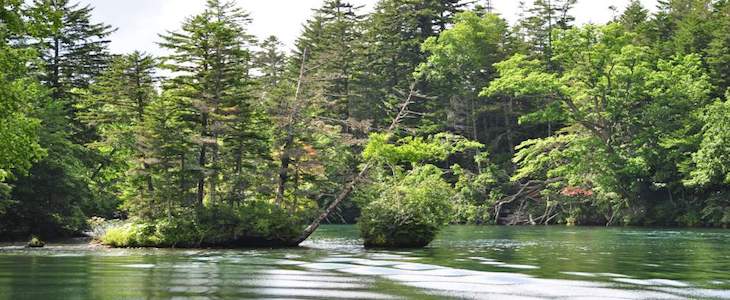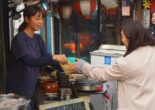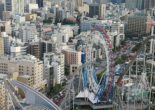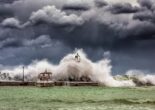
Most tourists land in Osaka or Tokyo but few make it to the north of Japan. The train takes very long and many hesitate to take another plane. To be fair, when one comes to Japan to see temples and shrines, you will be fairly disappointed with Hokkaido. But Ezo, as it used to be called, is home to some of the most unspoilt nature within Japan and is sure to take one’s breath away.
And don’t forget the amazing food. Mention Hokkaido to Japanese people and they will easily name you five dishes Hokkaido is known for, such as Ramen (Sapporo, Hakodate and Asahikawa Ramen being the famous Three), Jingisukan, Soup Curry, seafood, milk products and just vegetables in general.
You are thinking of going to Hokkaido in summer? Then check out a few of these places:
Sapporo
Sapporo is the prefecture’s capital with around 2 million people but walk through the city and you will seriously start wondering where these 2 million people are. Streets are bigger, everything is more spacious, people are fewer but the city offers (nearly) everything Tokyo does. Adding to this, the temperature is not too high and people actually spend their days and evenings outside in the parks. Something that is unthinkable in central Japan because the heat and humidity will slowly kill you. Visit the city in July and August and you will be able to enjoy the Sapporo Summer Festival with music, fireworks and beer gardens.
Sights: Odori Park, Sapporo Beer Museum, Clock Tower, Mount Koiwa
Food: Sapporo is famous for Soup Curry and Miso Ramen as well as seafood and of course Sapporo Beer (it is strongly recommended to do the beer tasting at the museum)
Getting around: most can be reached by walking or by taking the subway
Getting there: Shin-Chitose Airport is the closest airport to Sapporo and can be reached by most cities within Japan. Getting to Sapporo by train is possible, but it takes around 8 hours from Tokyo via Hakodate and it can actually be more expensive than flying. If one wants the enjoy the scenery and has time for a stop at Hakodate though, this is a great alternative to flying.
Otaru
Otaru is a nice harbor town easily reachable from Sapporo. The town is famous for two things; its canal lined with old warehouses and glass production. The warehouses along the canal house little shops and cafes and make for a pleasant stroll both during the day and at night.
Sights: Canal Area, city center (Sakaimachi street)
Getting around: walking is the way to go
Getting there: Take the direct JR train from Sapporo Station to Otaru, which takes less than an hour.
Akan National Park
Akan National Park is located in eastern Hokkaido and consists of three lakes: Lake Akan, Lake Mashu and Lake Kussharo. Lake Akan as well as Lake Kussharo offer various outdoor activities around the lakes as well as accommodation, hot springs and shops. Lake Akan is particularly famous for its Marimo algae; round algae balls that grow inside the lake and can have a diameter of over 30cm (Marimo can be found in other countries but nowhere as big as in Lake Akan). The lake and the algae are best explored through a lake cruise that takes a little bit over an hour and which stops at a tiny island in the middle of the lake where you get to see Marimo algae in a small exhibition room. As it is often in hot spring towns throughout Japan, the towns often have a somewhat idiosyncratic aged charm as tourists tend to spend their limited time inside the hotels. Lake Akan is not that much different and the town center doesn’t hold much except souvenir shops that sell the same products and a separate street with Ainu handicrafts. But Lake Akan itself is mesmerizing and one can enjoy the nature around the lake on several hiking paths.
Lake Mashu is known for two things; first, it is supposed to have the clearest water in the world and second, the lake is nearly always covered in fog. It is prohibited to walk down to the lake and there are not many facilities close-by except for a visitor center at observation deck 1. From here you can start on a hiking trail along the caldera. Despite being infamous for attracting bad weather, Lake Mashu might offer impressive views even on foggy days when you can observe the clouds flowing over the crater.
The three lakes can all be reached within one day but it could be a good idea to stay somewhere a night or two as there are other, smaller lakes to explore as well as some hot springs inside the forests (eg. Lake Onneto).
Sights: The three lakes (Akan, Kussharo and Mashu) and Kawayu Onsen.
Getting around: Even though there are a few buses going from one lake to the other, it is highly recommended to rent a car. If you have only one day available, it is not possible to visit every sight with a bus as they are few and infrequent but it is manageable with a car.
Getting there: The closest airport is Memanbetsu Airport (45 min from Sapporo). From there you can take a car to reach the park (up to 2 hours). You can also drive all the way from Sapporo (ca. 6 hours) or take the train via Kushiro (Sapporo – Kushiro 4 hours). From Kushiro I strongly recommend to rent a car.
Kushiro Marshlands
Kushiro Marshlands offer you the only chance to observe the endangered Japanese Crane in the wild. Most is off-limits to tourists and can only be enjoyed from viewing points but some parts of the marsh- and wetlands can be walked in short 1 to 2 hours tours from some of the viewing points. Some are even accessible to wheelchair users. The park is located between Kushiro and Akan National Park and everything can easily be combined when one decides on renting a car.
Getting around: Renting a car is the best option as again, buses are rare. Some visitor centers along the park provide information on the park and from there you can also start on some short walking tours through the marsh- and wetlands.
Kushiro City serves as a good starting point for both the Kushiro Marshlands as well as Akan National Park. The city itself has not much to offer except seafood, hotels and rental car agencies close to the station but among the Japanese the city seems to hold a certain aura and has been a romantic topic of folk songs in the past.
Getting there: Kushiro can be reached from Sapporo within 4 hours with a limited express train.
Note: the walks through the wetlands are not only for the fit but as it is pure nature, it is recommended to wear long trousers and maybe some mosquito repellent as you will find yourself surrounded by plenty of insects. Hokkaido might not be humid but once you enter the wetlands, the level of humidity rises drastically. Most parts of the paths are well maintained, some seem to be nearly non-existent and you have to walk through high grass and bushes.
Shiretoko National Park
The Shiretoko National Park in the north-east of Hokkaido is a designated UNESCO world heritage site and it is not hard to understand why. It is one or possibly THE wildest and most unspoilt place you can find in Japan. The whole northern part of the peninsula is off-limits to tourists and trespassing can result in heavy fines or serious danger for your health. Shiretoko is home to Japan’s biggest brown bear population and as a tourist one has to adhere to certain rules in order to protect oneself as well as the bears. There are two cities in the park; Utoro is a popular hot spring destination and offers hotels and some restaurants. Rausu on the other side of the peninsula offers less tourist facilities but is popular for whale watching cruises.
Sights: From Utoro you can join one of the many peninsula cruises that take from one to three hours and can go all the way up to the top. The cruises allow you to see the breathtaking cliffs, waterfalls and possibly even brown bears that often hang around on the beach. Whale watching cruises leave from Rausu and take two to three hours. The beautiful Five Lakes can be easily reached from Utoro and offer an easy hiking/walking trail around the small lakes. Note that the lakes might be temporarily closed due to bear sightings. Not too far from the Five Lakes are the Kamuiwakka Hot Spring Falls. Parts of the hot spring waterfall are closed but the first part can be walked and there are natural pools that allow you to take a bath.
Food: Utoro and Rausu are also harbor towns, so seafood is plenty and very delicious. Uni (sea urchin) and Ikura (red caviar) are very prominent as well as Sashimi of all sorts and Hiraki Hokke (grilled Okhotsk Mackerel).
Getting around: Public transport in July and August is surprisingly good from Utoro to Kamuiwakka via Five Lakes. There are a few buses connecting Utoro with Shari, the closest town with a train station. Rausu can also be reached from Utoro via bus but as there are only a few available, it is best to always check the timetable well in advance. To reach Rausu from Utoro and explore the other side of the peninsula, it is advisable to rent a car. If one only stays on the Utoro side, public transport is enough during July and August. The mountain pass connecting Utoro with Rausu is closed in the winter but during summer it offers you spectacular views on Mount Rausu and passes some hot springs along the way.
Getting there: There are a few buses departing from Sapporo to Shiretoko, which take around 8 hours. The closest airport is Memanbetsu airport and there are a few buses connecting the airport with Utoro. Otherwise, you can take the train to Shari and take a bus from there to either Utoro or Rausu (Utoro is better connected to public transport than Rausu).
Note: As amazingly beautiful Shiretoko is, there are wild animals living there. Incidents with bears rarely happen but only because the locals know how to live in respectful cohesion with the big bears. Do not ever feed animals of any kind and do not carry food with you when out in the forests. Do not litter and do not approach any animal. Deers and foxes are plenty and are not as fearful as they should be. Don’t try to touch them as they can carry diseases. When driving a car be very cautious as all sorts of smaller and bigger animals might unexpectedly cross the streets. The Kamuiwakka Hot Spring Falls do not offer any facilities and walking up can be slippery and dangerous. Summer in Shiretoko can be much cooler than even in Sapporo and it is not rare for the temperatures to drop down to under 15 degrees including some fog and rainfall.
Got some inspiration?
Then I hope you will enjoy your Hokkaido travels.
And if you are looking for a place, feel free to contact us via our websites TokyoRoomFinder and JapanRoomFinder. We are happy to assist you in finding a place in a shared house, shared apartment or your own private apartment.



